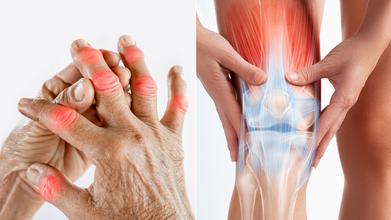- Health Conditions A-Z
- Health & Wellness
- Nutrition
- Fitness
- Health News
- Ayurveda
- Videos
- Medicine A-Z
- Parenting
- Web Stories
Can Scorpion Venom Really Treat Breast Cancer? Here’s What Experts Say

Credits: Canva
Breast cancer continues to be the most common cancer among women globally and the second leading cause of cancer-related deaths, according to the World Health Organization (WHO). In 2022, there were 2.3 million new cases and roughly 670,000 deaths due to breast cancer. Projections suggest that by 2050, new cases could rise to 3.2 million with over 1 million deaths annually.
Interestingly, in a notable scientific development, researchers in Brazil have suggested that scorpion venom might have the potential to help treat breast cancer. According to findings presented at FAPESP Week France, scientists at the University of São Paulo discovered a molecule in the venom that acts in a way similar to a chemotherapy drug used to destroy cancer cells.
Early results from the study indicated that a molecule called BamazScplp1, derived from the venom of the Brotheas amazonicus scorpion, showed anti-cancer properties in lab tests. We spoke with Dr. Sumol Ratna, Assistant Professor in the Department of Medicine at NIIMS Medical College & Hospital, to better understand whether this could actually be possible.
What Is BamazScplp1?
The University of São Paulo team has compared BamazScplp1 to the chemotherapy drug Paclitaxel, noting that preliminary lab tests show similar effectiveness in killing breast cancer cells. BamazScplp1 belongs to the serine protease enzyme family, which helps break down proteins and may interfere with cancer cells’ growth and survival. The researchers observed that the molecule triggers cancer cell death through necrosis, a process usually harmful in the body but potentially useful for destroying tumors during cancer treatment.
As harvesting venom directly from scorpions is impractical, the team turned to a biotechnological approach called Heterologous Expression. This involves inserting the gene responsible for the molecule into microorganisms, like yeast, to produce it in larger amounts. Professor Elian Arantes, the lead researcher, noted that they used the yeast Pichia pastoris, a species widely used in biotech for its efficiency. This method enables mass production of BamazScplp1 without causing harm to the animals.
The discovery of BamazScplp1 offers fresh hope in the battle against breast cancer, but how realistic is it?
Can Scorpion Venom Really Cure Breast Cancer?
Scorpion venom has attracted scientific interest for its potential in breast cancer treatment. However, Dr. Sumol Ratna emphasized that scorpion venom is not an approved treatment for breast cancer or any other human tumors. He further told us that though some compounds in the venom have shown anti-cancer activity in early lab studies, certain peptides appear to slow cancer growth, reduce spread, and trigger cell death. But so far, no major health authorities, including the FDA, ICMR, or WHO, have approved scorpion venom or its extracts for cancer therapy.
Patients should always consult oncologists before considering experimental treatments. Currently, the most effective and evidence-based options for breast cancer remain surgery, chemotherapy, radiation, hormone therapy, and targeted immunotherapies.
New Developments Like Lower Doses of Radiation And Drug-filled Cartilage Could Help In Arthritis Treatment

Credits: Canva
Each year on October 12 the world observes Arthritis Day to bring attention to the medication condition and ways to find out to prevent and to treat it as there is no cure. However, apart from the traditional treatments like medication, physical therapy, lifestyle changes, and surgery to manage symptoms, there have ben new treatments in the recent times too. Before jumping into what those treatments are, let us first understand what is arthritis?
It is a medical term for joint pain, inflammation, and stiffness, with over 100 different types. It also includes osteoarthritis and rheumatoid arthritis.
Osteoarthritis: It is a progressive, degenerative joint disease where the protective cartilage cushioning the ends of the bones breaks down. It then causes pain, stiffness, swelling and reduced mobility and affects the hands, knees, hips and spine.
Rheumatoid Arthritis: It is a chronic autoimmune disease that causes pain, swelling, stiffness, and warmth in the joints and affects mostly small joints of hands and feet in a symmetrical pattern. It occurs when the immune system attacks the body's own tissue, particularly the lining of the joints and leads to inflammation or even damage to cartilage and bones.
What Are The New Treatment On Arthritis?
As per the multiple new studies present at the American Society of Radiation Oncology (ASTRO), 2025, researchers from Korea, the US, and Germany reported that mild doses of radiation can significantly reduce pain and also improve mobility in patients with osteoarthritis.
Radiation Therapy For Arthritis
In South Korea, a randomized clinical trial was conducted with 114 volunteers, who had knee arthritis, and were treated with 3 Gy of radiation, which had spread over six sessions. Researchers also noticed that 70% of participants experienced meaningful improvement in pain, function and overall functioning. This was way higher than the 42% improvement seen in the placebo group.
Low-dose radiation is already common in the Europe. However, strong randomized data was limited till now. Dr Byong Hyuck Kim of the Seoul National University, who led the study also emphasized that here, the radiation doses are 10 to 20 times lower than cancer therapy levels and targets only the joints far from the vital organs.
Artificial Cartilage Helps Arthritis
Researchers from the University of Cambridge designed an artificial cartilage that could help with arthritis treatment. This 'cartilage' can sense tiny changes in the body, including arthritis flare-up and release drugs exactly when and where they are needed.
The 'cartilage' is squishy in nature and can be loaded with anti-inflammatory drugs that are released in response to small changes in pH in the body. During arthritis flare-up, joint becomes inflamed and more acidic. The 'cartilage' becomes softer as the change in pH is noticed, especially when the acidity increases and it triggers the release of drug molecules that can be encapsulated within its structure.
The entire study is published in the Journal of American Chemical Society.
World Arthritis Day 2025: Date, Theme, Significance And History Explained

Credits: Canva
Every year, people across the world unite on World Arthritis Day to spread awareness about arthritis and related disorders. Observed annually on October 12, the day aims to draw attention to the everyday challenges faced by those living with arthritis, encourage early diagnosis, and promote better medical care and support systems.
As World Arthritis Day 2025 approaches, it’s a timely reminder to learn about its theme, importance, and the role each of us can play in improving the lives of those affected.
Why World Arthritis Day Matters
Arthritis is often mistaken for a simple case of joint pain, but it is far more complex. It includes a wide range of conditions that can impact a person’s mobility, independence, and overall well-being. One of the main goals of World Arthritis Day is to break these misconceptions, spread accurate information, and raise awareness that arthritis can affect anyone, regardless of age.
Raising awareness also encourages timely medical consultation, physiotherapy, and healthier lifestyle choices that can help manage symptoms and prevent complications.
World Arthritis Day 2025 Theme
The theme for World Arthritis Day 2025 is “Realizing Your Dreams” or “The Courage to Dream.” This year’s message highlights the importance of personal aspirations and resilience among people living with rheumatic and musculoskeletal diseases (RMDs). It inspires individuals to pursue their dreams while encouraging collaboration between patients, doctors, and advocates to turn those dreams into reality.
The theme serves as a reminder that arthritis is not just a physical condition, it is about preserving one’s independence, dignity, and quality of life.
When Is World Arthritis Day Celebrated?
World Arthritis Day is marked every year on October 12 around the globe. In India too, this day is recognised and observed to underline the importance of awareness and education about arthritis. With lifestyle changes and rising stress levels, arthritis is now being diagnosed in younger people as well, making awareness even more vital.
Ways to Raise Awareness on World Arthritis Day 2025
Spreading awareness is not limited to medical professionals or organizations. Every individual can help in small but meaningful ways. Some simple ideas include:
- Educational Programs: Schools, offices, and community groups can organize sessions to teach people about arthritis symptoms and preventive care.
- Social Media Campaigns: Sharing real-life stories, verified facts, and official theme posters can reach thousands online.
- Community Events: Walkathons or charity runs can raise both funds and awareness.
- Free Health Camps: Clinics and hospitals can offer free joint check-ups to encourage early diagnosis.
These collective efforts ensure that arthritis is not ignored or misunderstood, but openly discussed and addressed.
Tips for Living with Arthritis
Awareness is the first step, but supporting those who live with arthritis every day is just as important. Here are some ways to help manage the condition and maintain a good quality of life:
Stay Active, but with Care
Choose gentle exercises such as walking, yoga, or swimming to keep joints flexible and reduce stiffness without straining them.
Eat a Balanced Diet
Include anti-inflammatory foods such as leafy greens, fatty fish rich in omega-3, nuts, and olive oil to help ease inflammation.
Get Enough Rest
Quality sleep helps the body recover. Avoid overexertion but stay active enough to prevent stiffness.
Use Supportive Tools if Needed
Walking sticks, braces, or other assistive devices can reduce stress on joints and make movement easier.
Maintain a Positive Outlook
Joining arthritis support groups or connecting with others who share similar experiences can provide motivation and emotional support.
For those seeking specialized treatment, visiting a reputed multispeciality hospital in Coimbatore can help patients receive comprehensive arthritis care, from diagnosis to therapy and rehabilitation, under one roof.
Is Donald Trump Showing Early Phonemic Paraphasia? Here’s Why Health Experts Think So

As Donald Trump recently went for his second health checkup, the visit, announced earlier this week by the White House comes as he prepares to travel to the Middle East following a ceasefire deal in the Israel-Hamas war. White House press secretary Karoline Leavitt called it a “routine yearly checkup,” even though the president had already undergone his annual physical in April. According to a memo obtained by CBS News on Friday evening, written by Trump’s physician, Capt. Sean Barbabella, the president “successfully completed a scheduled follow-up evaluation.”
The president also received his annual flu vaccination and an updated COVID-19 booster. Interestingly, his cardiac age, a validated measure of cardiovascular health via ECG was found to be roughly 14 years younger than his chronological age. However, health experts remain concerned, with many noting potential signs of dementia. Now, some specialists are also pointing to early indicators of phonemic paraphasia in his speech.
What Is Phonemic Paraphasia That Health Experts Believe Donald Trump Has Signs Of?
Phonemic paraphasia is a type of speech error where sounds within a word are substituted, added, or rearranged, creating a nonword that still sounds similar to the intended word (for example, “tephelone” instead of “telephone”). It is commonly seen in language disorders such as Wernicke’s aphasia and conduction aphasia, caused by difficulty selecting the correct phonemic segments. People with this condition usually understand what they want to say but struggle with producing the correct sounds.
What Are Psychologists Saying About Donald Trump’s Health?
Even during Trump’s first term, his cognitive and psychological traits attracted attention. Observers noted he struggled to focus on a single topic, and his public remarks raised concern among psychiatrists. In 2017, 27 mental health professionals collectively published The Dangerous Case of Donald Trump, warning that his mental state, combined with presidential powers, could pose risks to global security.
Dr. Bandy Lee, who taught for 17 years at Yale School of Medicine, first noticed potential neurocognitive issues in Trump in 2017 and says his condition has steadily declined since then. The manifesto, published on Nov. 3, 2024, titled Statement on Cognitive Decline in the Presidential Election, lists symptoms including simpler vocabulary, incomplete sentences, grammatical mistakes, paraphasias, vague or inappropriate statements, compulsive repetition of thoughts (“perseveration”), increased use of profanity, and pronounced narcissistic traits.
Some of Trump’s invented words even went viral during his first term. The infamous “covfefe” tweet is one example, where he likely meant “coverage” but created a nonsensical word that became a meme and appeared on protest signs and in advertisements.
Health Experts Believe Donald Trump Also Has Dementia
Harry Segal, a senior psychology lecturer at Cornell University, has observed early signs of dementia in Trump. “What’s alarming is how the rate of Trump’s unusual speech and political decisions has been increasing. He once gave an incoherent answer about childcare to the Economic Club of New York… Trump has shown evidence of dementia over the past year, indicated by his strange gait, phonemic paraphasia, and a decline in word complexity,” Segal said. He believes these factors explain Trump’s refusal to debate Kamala Harris a second time and his increasingly impulsive speeches.
What Are the Symptoms of Phonemic Paraphasia?
The main symptom is substituting a word with a nonword that sounds similar, such as saying “wishdasher” instead of “dishwasher.” Other signs include:
- Errors where sounds in a word are replaced with different sounds
- Producing non-real words that resemble the intended word
- Difficulty finding words and substituting unrelated terms (semantic paraphasia)
- Repeated attempts to correct themselves, sometimes abandoning the word entirely
- Lack of awareness of these mistakes
Who Is Affected by Phonemic Paraphasia?
- Individuals with aphasia: Particularly Wernicke’s and conduction aphasia
- People with brain lesions: Often in the posterior temporal lobe or internal/external capsules, areas involved in language
- Individuals with other neurological conditions: Early dementia is frequently associated with phonemic paraphasia
© 2024 Bennett, Coleman & Company Limited

